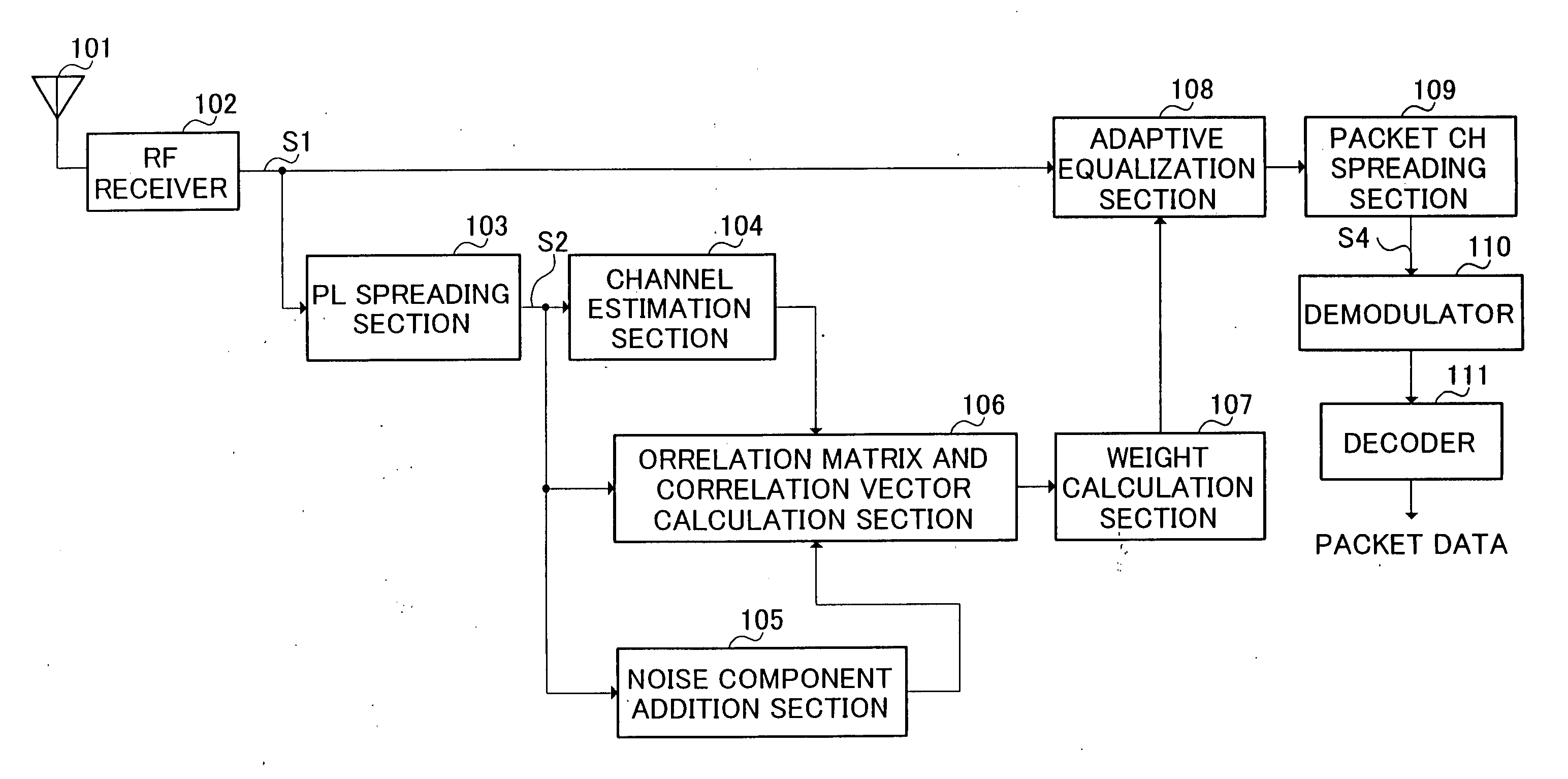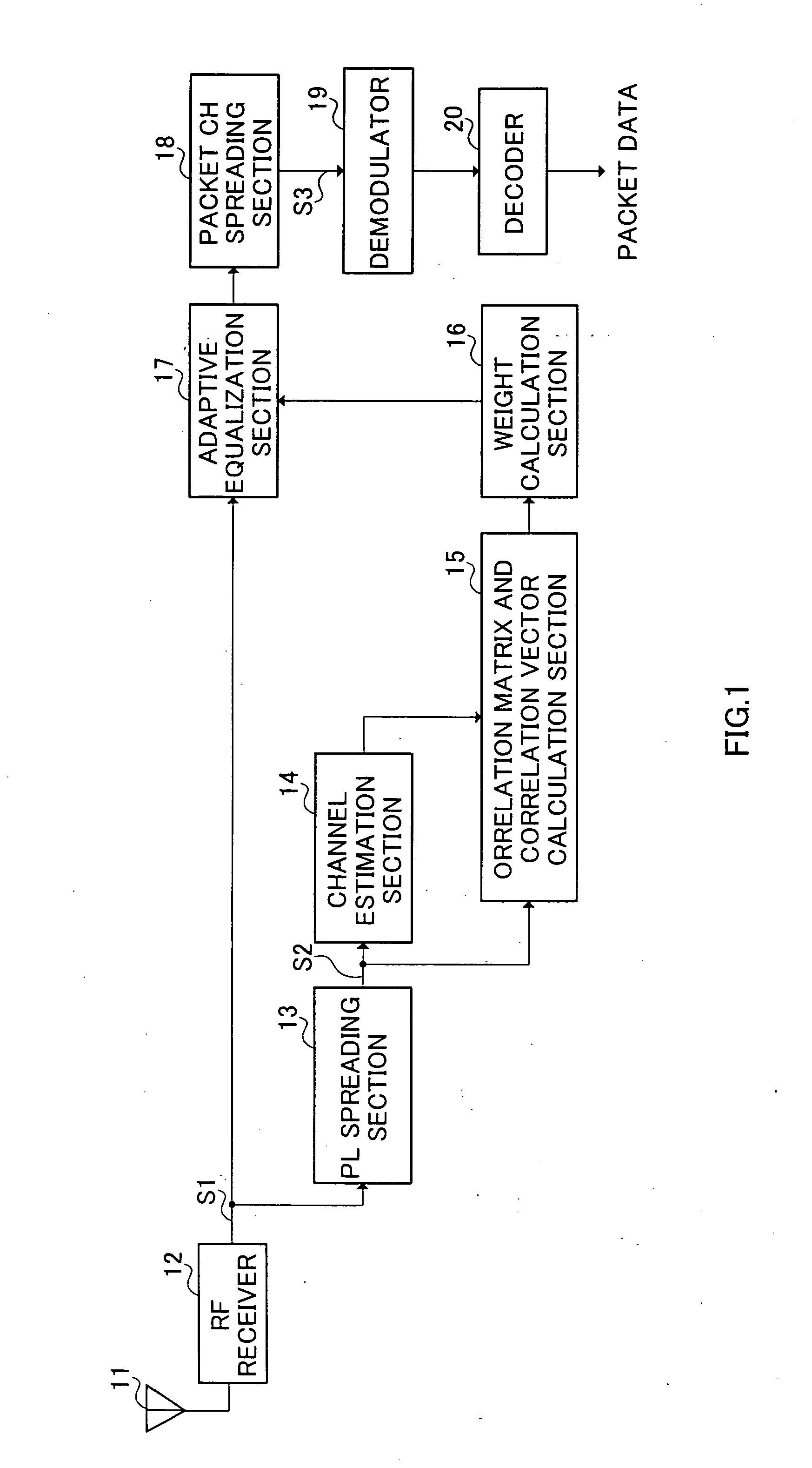Reception device and reception method
a reception device and reception method technology, applied in the field of reception apparatus and reception method, can solve the problems of channel not being obtained, multi-path fading, and comparable spreading gain, and achieve the effect of reducing noise enhancemen
- Summary
- Abstract
- Description
- Claims
- Application Information
AI Technical Summary
Benefits of technology
Problems solved by technology
Method used
Image
Examples
embodiment 1
[0038]FIG. 3 is a block diagram showing a configuration of a reception apparatus in a communication terminal apparatus according to Embodiment 1 of the present invention. In this figure, antenna 101 receives signal transmitted from a base station apparatus, and outputs the received signal (reception signal) to RF receiver 102.
[0039] RF receiver 102 implements predetermined radio reception processing (a down conversion, A / D conversion and suchlike) on the reception signal and outputs the signal after radio reception processing to adaptive equalization section 108 and PL spreading section 103.
[0040] PL spreading section 103 despreads the signal outputted from RF receiver 102 using spreading code created by spreading the common pilot signal in the base station apparatus, and outputs the signal after despreading to channel estimation section 104, noise component addition section 105 and correlation matrix and correlation vector calculation section 106.
[0041] Based on the signal outpu...
embodiment 2
[0060]FIG. 5 is a block diagram showing a configuration of a reception apparatus in a communication terminal apparatus according to Embodiment 2 of the present invention. In FIG. 5, the same parts as in FIG. 3 are assigned the same reference numerals as in FIG. 3 to omit detailed explanations thereof. The difference between FIG. 5 and FIG. 3 is that in FIG. 5, minimal component removing section 301 substitutes for noise component addition section 105 in FIG. 3.
[0061] Minimal component removing section 301 evaluates the maximum value of input signal vector max (r (n)) using despreading result of input signal outputted from PL spreading section 103. Then, minimal component removing section 301 multiplies max(r(n)) by a constant relativeSNR which is dependent on spreading factor of common pilot channel and spreading factor of packet channels and calculates a noise equivalent value noise_power, using Equation (8) explained in Embodiment 1. Furthermore, minimal component removing sectio...
embodiment 3
[0066]FIG. 6 is a block diagram showing a configuration of a reception apparatus in a communication terminal apparatus according to Embodiment 3 of the present invention. In FIG. 6, the same parts as in FIG. 3 are assigned the same reference numerals as in FIG. 3 to omit detailed explanations thereof. The difference between FIG. 6 and FIG. 3 is in that in FIG. 6, inter-cell interference ratio calculation section 401 is provided and noise component addition section 402 substitutes for noise component addition section 105 in FIG. 3
[0067] Inter-cell interference ratio calculation section 401 calculates estimatedCIR which is a ratio of the subject cell interference component to other-cell, interference component based on signal outputted from PL spreading section 103. More specifically, estimatedCIR is calculated from value obtained by averaging the input signal vector expressed by Equation (1) for a long time. The calculated estimatedCIR is outputted to noise component addition section...
PUM
 Login to View More
Login to View More Abstract
Description
Claims
Application Information
 Login to View More
Login to View More - R&D
- Intellectual Property
- Life Sciences
- Materials
- Tech Scout
- Unparalleled Data Quality
- Higher Quality Content
- 60% Fewer Hallucinations
Browse by: Latest US Patents, China's latest patents, Technical Efficacy Thesaurus, Application Domain, Technology Topic, Popular Technical Reports.
© 2025 PatSnap. All rights reserved.Legal|Privacy policy|Modern Slavery Act Transparency Statement|Sitemap|About US| Contact US: help@patsnap.com



